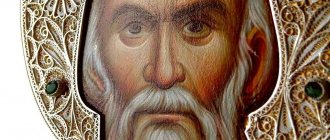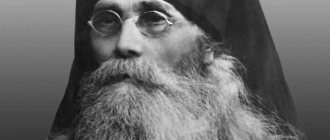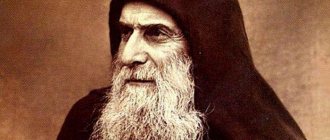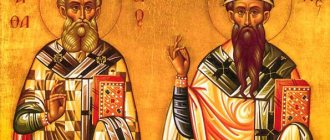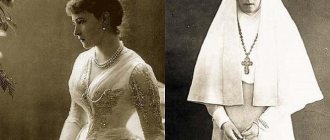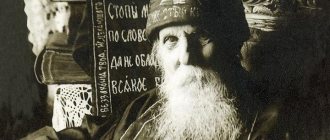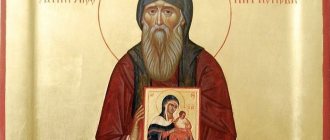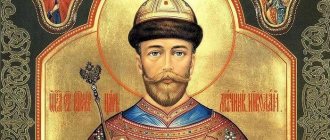The Krypetsky St. John the Theologian Monastery is located in the Pskov region at a distance of 22 km from Pskov and 7 km from the village of Kripetsky. This large and bright monastery was built back in 1557 by the Serb monk Savva Krypetsky, a native of Mount Athos. Now his relics rest there, as well as the relics of Cornelius Kripetsky, who lived here in the late 19th - early 20th centuries.
Also on the territory of the monastery there is a healing lake Kopanets. The name speaks for itself - this reservoir is made by human hand. Since ancient times, the water in this lake has been famous for its miraculous properties. Cornelius also treated parishioners and residents of the monastery for various ailments with the help of sacred lake water. Today Kopanets has its own font, intended for baptism and immersion.
Schedule of services in cathedrals and churches of the Krypetsky Monastery
© helicopter1915
In addition to the font and the lake, on the territory of the monastery there are also: St. John the Theologian Cathedral, the refectory Church of the Dormition of the Mother of God with a bell tower, the chapel of St. Savva of Krypetsky, the holy gates with the gate chapel of the Apostle John the Theologian, the chapel of St. Apostle Andrew the First-Called, the cross on the stone domed foot of the St. lakes, the grave of Archimandrite Damascus (Sakhnyuk), a hotel for visitors, a refectory, a monastery cemetery and a parking lot.
Life of St. Savva Krypetsky
The Monk Savva of Krypetsky was tonsured on Mount Athos, from where he arrived in Pskov. He began his Christian deeds on Snetnaya Mountain in the monastery of the Mother of God, near Pskov, then moved to a more secluded place on the Tolva River, to the monastery of St. Euphrosynus. Then he went into complete silence into the Krypetsk Hermitage, 15 miles from Tolva, and settled alone near a small lake in an impenetrable forest. The hermit's food was bread and water, and on Wednesday and Friday he ate nothing. In his hermit life, he suffered a lot from unclean spirits, but he always defeated them with prayer. After several years of solitary life, those who wanted a desert life began to gather at Savva’s place. They begged him to create a monastery and build a temple in honor of the Apostle and Evangelist John the Theologian. Savva refused to be abbot of the monastery and entrusted the management to the monk Cassian . Many residents of Pskov came to the monk Savva, whom he healed and exhorted, but did not accept gifts from anyone.
One day, the Pskov prince Yaroslav Vasilyevich Obolensky , who often visited the monastery, came to the monk along with his sick wife. Savva sent to tell him: “The elder, sinful Savva, tells you, prince, do not enter the monastery with the princess; We have such a rule here - wives should not enter the monastery: if you break the father’s commandment, your princess will not receive healing.” The prince asked for forgiveness that, out of ignorance, he wanted to violate the charter. Then Savva, together with the brethren, went out of the gate and served a prayer service. The princess recovered. At the request of the prince in 1487, Pskov received a charter for land for the monastery.
Savva taught the laity to observe cleanliness, reminding them of the apostolic judgment against those who defile the body. He told the rich and judges not to feed at the expense of the poor and to observe the truth. He often reminded everyone to avoid quarrels and enmity, to maintain love and peace, and to cover the mistakes of others with leniency, so that we too would be forgiven. A strict dormitory system was introduced at the monastery from the very beginning. And then, when enough brothers and funds had gathered, there was nothing in Savva’s cell except two icons, a mantle and a matting, on which he lay down to rest. Savva commanded the monks to cultivate the land with their own hands. He said: “Why do we call the ancient ascetics our fathers when we do not live their lives as children should. They, homeless, beggars, spent time in dens, in deserts and for the Lord with all firmness they subjugated their flesh to the spirit, they knew no rest either day or night. Let us love, children, the good Lord; let us not only show our love for Him through sounds and clothing, but through deeds: love for each other, tears, fasting, all abstinence, as the ancient fathers did.”
Monk Savva reposed on August 28, 1495.
What do they ask the Reverend for?
The holy elder, who devoted his entire life to serving the Lord, is prayed for forgiveness of sins, intercession before the Savior, and healing from illnesses. The holy monk served Christ faithfully and truly. He earned the right to enter the Kingdom of Heaven and received eternal life in paradise. Savva looks from heaven to earth and helps believers live their lives with Christ in their hearts.
The holy elder is addressed in such cases:
- illness of relatives;
- unfair court decision;
- harassment from superiors;
- enemy attack;
- natural disasters;
- difficulties in raising a child;
- family problems.
Believers who fear demonic temptations and want to strengthen their faith in the Savior pray to Savva. The saint is asked to intercede with the Lord and forgive sins. They pray to the elder to return the heretics to the fold of Orthodoxy and forgive their sins. A miracle worker has the power to heal any disease, rid the land of enemies, and save from natural disasters.
Miracles and veneration of St. Savva of Krypetsky
After his death, Savva repeatedly provided assistance to the monastery. One night, robbers approached the monastery. But they saw a handsome old man, who, holding a rod in his hand, menacingly ordered them to repent. The next morning they learned that there was no such elder in the monastery, and they realized that it was the Monk Savva himself. The leader of the robbers repented to the abbot and remained to live in the monastery.
The Monk Savva was tall, with a beard as gray as snow, round, thick and not very long. In this form he appeared to the monk Isaiah , indicating where his incorruptible relics were located. Then, in 1555, at the request of the Krypetsk brethren, the Pskov priest Vasily wrote the Life of St. Savva, and a celebration was established for him.
Reviews
Everyone who visited the Krypetsky Monastery near Pskov leaves here with a bright head and positive emotions. Guests note the special friendly atmosphere. The territory of the monastery is very well-groomed and cozy: there are many garden beds, a cowshed and blooming apple trees. Parishioners always want to spend as much time as possible here in peace and love.
Of the minuses: the path to the monastery is not easy. This place fits perfectly with the saying “Quiet, quiet, and God’s grace.” A dirt road leads to the territory, to which you first need to drive 25 kilometers from Pskov.
Panorama of the Krypetsky Monastery
Troparion and Kontakion to St. Savva of Krypetsky
Troparion, tone 8.
ABOUT! you, Father Savo, know the speed of salvation. Let us accept the cross, for you followed Christ. But whoever does and learns to despise the flesh passes away, but to practice things more immortal for the soul. In the same way the angels rejoice, O venerable spirit.
Kontakion, tone 2.
Divinely armed with purity of soul, and unceasing prayer, as if firmly handed over a copy, you prosecuted the demonic militia of Savo, Our Father, pray unceasingly for all of us.
Shrines[edit]
- The relics of St. Savva Krypetsky and Kornily Krypetsky
- List of the Tikhvin Icon of the Mother of God
- Reliquary containing a particle of the Life-Giving Tree of the Lord and holy ascetics
- Icon of the Mother of God, called “Iverskaya”
- Icon of the Venerable Prince Fyodor and his sons David and Constantine
- Icon of the Holy Martyr Tatiana
- Ancient icons of St. Savva of Krypetsky and St. Euphrosynus of Pskov
- Lake of St. Savva Krypetsky
Rev. Savva Krypetsky. Icons
The Venerable Savva of Krypetsky is traditionally depicted on icons in monastic vestments, with a blessing right hand.
Apostle John the Theologian, Saint Savva of Serbia, Saints Euphrosynus of Pskov, Savva of Krypetsky with their lives. Pskov, 1702. From the Church of St. John the Evangelist of the Krypetsky Monastery. Pskov, PGOIAKHMZ
Reverend Savva Krypetsky fights demons. 17th century
Reverends Savva of Krypetsky, Euphrosynus of Pskov and the blessed Prince Gabriel. XIX century
Rev. Savva Krypetsky. All the saints in the Russian land shone forth (fragment). Nun Juliania (Sokolova). Moscow, late 1920 - early 1930. Sacristy of the Trinity-Sergius Lavra
The Venerable Savva of Krypetsky is depicted on a 16th-century painting. Tsate is a carved Deesis tier of eight figures, which is placed in openings formed by columns and keeled frames. Among the upcoming ones are the Pskov holy princes Dovmont-Timofey and Vsevolod-Gabriel. In the middle at the feet of Christ are the kneeling Pskov saints Euphrosynus of Pskov and Savva of Krypetsky, the founders of the Spaso-Eleazarovsky and Krypetsky monasteries. The field of the upper part of the tsata is a black floral ornament. The arches and pillars are decorated with stripes of dark blue and pale green enamel.
Tsata. Pskov, XVI century. Deesis, Venerable Euphrosynus of Pskov, Venerable Savva of Krypetsky. Pskov State historical, architectural and art museum-reserve
Down to the ground
Memories from the trip to the St. John the Theologian Krypetsky Monastery, undertaken by the Pskov branch of the All-Russian Society for the Protection of Historical and Cultural Monuments (VOOPIiK) on September 28, 2007, are as fresh as “roses thrown into a coffin.” This is not false pathos - this is the only possible definition of everything seen there.
VOOPIiK began receiving alarming calls in the spring of 2007. The scale of new construction taking place in the currently operating monastery shocked even a tourist inexperienced in preserving historical heritage. It is the tourist (not the pilgrim) who now, unfortunately, may have a reasonable question: where is it here, my heritage? Where are the monuments of the second half of the 16th century: the bell tower, the refectory, the cathedral with a gallery adjacent to the belfry? After reviewing all the updates, specialists who arrived in Krypetsy at the end of last week tried to find answers to this question.
"Non-acquisitive disposition"
The road to the monastery is difficult: a comfortable minibus covers about 22 kilometers in an hour. The weather is favorable, except that there is a lot of dust, but after the rain of road jelly it would be worse to slurp. Let's go, don't complain. The Monk Savva was carried into this “wildness of pine forests.” And now this is a natural wilderness, although all the benefits of civilization seem to be just a stone’s throw away and a mobile phone “within the network coverage area,” but in the 15th century...
The Krypetsky Monastery has always been a place of solitary and quiet life. Photo: Lev Shlosberg, 1981
How cold and scary it could be here alone. However, the Monk Savva, unlike us, weak in body and even weaker in spirit, was not alone. It was easy for him to sacrifice the comforts of life in the Pskov Snetogorsk monastery and it was not enough for him to go to the monastery of St. Euphrosynus on the Tolva River. The desire to serve a higher purpose required complete solitude. Yes, that’s right: the monk desired the feat of living in the desert.
Here it would be necessary to self-critically note that it is not special preparation for it that prompts such reflections during an hour-long trip. The memory of the Monk Savva Krypetsky is celebrated on September 10. The Divine Liturgy with a solemn prayer service to the founder of the monastery is considered by the Pskov media to be a worthy information occasion, and they do not forget to provide a brief retelling of the life of Savva Krypetsky. For two weeks, even the most oppressed memory of vanity can retain this retelling.
But, moving through the darkish (even on a sunny day) forest on the way to the place of the heroic deed and resting place of the Monk Savva, it seems that you always knew the history of the monastery. And any night you wake up, you will begin to tell “in your own words” that Savva came to Pskov from distant lands. Perhaps “from Mount Athos,” and perhaps from the Serbian land, fleeing, like many Orthodox Christians, from Turkish persecution.
Once again you will remember that initially the future founder of the St. John the Theologian Krypetsk monastery was accepted by the Snetogorsk monastery. But the freedom of life in a monastery close to the city was not to the liking of the monk Savva. And he went to the monastery of the Monk Euphrosinus (Eleazar) in the present-day Spaso-Eleazarovsky Monastery, where he was entrusted with the duties of a monastic servant. Savva served in the monastery zealously and humbly, and then, asking for blessings, he went to the Krypetsk Hermitage.
He saved himself there through prayerful labors, ate nothing except water and bread (and, as it is said in the life, on Wednesdays and Fridays he ate nothing at all). But he was not allowed to lead a completely reclusive life. Whether the monk wanted it or not, the fame of his humility, selflessness (“non-covetous disposition”) and labors spread across the earth. Students began to flock to him from Pskov and surrounding places. By this time, the desert dweller had built a small church in the name of St. Evangelist John the Theologian.
Not only students came to him, but also people from the world: mayors, boyars, pious Pskovites. He accepted everyone and helped with spiritual advice: “In this way he arranged the salvation of many souls, and some of those who came to him did not want to return to the world anymore. The mayors and boyars began to give property for the construction of the monastery, but the monk refused to be abbot and entrusted the management to the monk Cassian.”
The “non-acquisitive disposition” of the Monk Savva did not change, although the monastery now had enough funds. But there was still nothing in his cell except two icons, a mantle and a matting on which the monk slept. And he taught the brethren the same thing: “Why do we call the ancient ascetics our fathers, when we do not live their lives, as children should. They, homeless, beggars, spent time in dens, in deserts and for the Lord with all firmness they subjugated their flesh to the spirit, they knew no rest either day or night. Beloved children of the good Lord, let us not only show our love for Him with sounds and clothing, but with deeds: love for each other, tears, fasting, all abstinence, as the ancient fathers did.”
The life also tells about the miracles of healing that took place in the monastery while Savva was alive, and about the fact that the already deceased monk did not leave the monastery under his protection. One day he appeared to robbers who wanted to rob the monastery and ordered them to repent. They repented. And their leader remained in the monastery. In the middle of the 16th century, the relics of St. Savva of Krypetsky were discovered; Savva himself pointed out their location when he appeared to the monk Isaiah. The founder of the monastery was “tall, with a beard gray as snow, round, thick and not very long”... The Monk Savva was a handsome man - in every sense.
But the monastery has more than just a spiritual history.
Bless and save?
The Krypetsky Monastery has known different times. In its history there were heydays, and complete desolation, and insult, and preparation for death. Desolation of the 17th century, restoration at the beginning of the 18th century. Evgeny Bolkhovitinov , who wrote a description of the Ion-Theological Krypetsky Monastery, liked to visit here For him, the monastery's refectory chamber was turned into the abbot's chambers.
Photo: Lev Shlosberg, 1981
The first description of the monastery of 1586-87 was published in 1996 in the work of Vl. V. Sedov “Pskov architecture of the 16th century”: “... the monastery of Ivan the Theologian is made of Krypetskaya stone, and in the monastery the church of Ivan the Theologian is stone, the porch is stone, and on the church there is a wooden cross... and on the cross the dove is gilded... Yes, Ivan the Theologian has the limit of Sava of Serbia... The Church of the Assumption of the Blessed Virgin Mary is a stone refectory... Yes, at the top above the Church of the Assumption of the Blessed Virgin Mary is the chapel of Ivan the Writer of the Ladder... Yes, between the church and the refectory there is a passage on pillars, and near the crossing there is a wooden rivet, and iron was riveted in it... Yes, near Savoy Serpsky there is the tomb of Sava the Wonderworker, and on there is a shroud... The Holy Stone Gates, and on them there are three three tops... and in front there are written saints. Yes, there is a wooden bell tower near the Church of St. Ivan the Theologian.”
At the beginning of the 20th century, the Krypetsky Monastery was one of the largest and richest monasteries in the Pskov land. It consisted of 40 monastics and 21 novices. The monastic lands amounted to 3,602 acres of land.
In 1918 the monastery was closed, and in 1923 the cathedral was also closed. The monastery was plundered. And in the 50s, a barnyard and a stable were built on the territory of the monastery.
But it was difficult to eradicate the memory of the holy monastery. In the same 50s, a wooden church with an iconostasis, a dome and a cross was erected over the grave of the blessed monk Cornelius. In September 1958, the chairman of the Toroshi village council, I. Denisov, together with Komsomol members, dismantled and burned the wooden church. But since the pilgrimage did not stop, in the 60s of the 20th century they decided to blow up the monastery.
He was saved by the famous defender of Pskov historical and cultural monuments, candidate of art history, poet and writer Elena Morozkina , who passed away in 1999. It was Elena Nikolaevna who ensured that the Krypetsky Monastery was not blown up, but was taken under state protection. She introduced this monument into scientific use: neither before nor after Elena Morozkina such studies of the complex of monuments of the St. John the Theologian Krypetsky Monastery were carried out. She first saw the monastery in 1957. Which one?
One short quote from her “Pskov Land”: “In the depths between the cathedral and the bell tower one can see an embankment: it is the gallery that connected them that has collapsed; Now between them, filling the empty space, tall linden trees quietly ring. Once there stood a multi-span belfry like the Pechersk one, forming the “backdrop” of the front monastery courtyard. The courtyard was paved with beautiful stone slabs. The cathedral, slightly covered from the main gate by the refectory, opened up behind it three-dimensionally, from the corner bordered by two diverging staircases. It stood on a high walkway, as if on a pedestal, crowned with a crown of jagged roofing. The refectory looked at the cathedral with elegant windows in beautiful frames, reminiscent of girls' kokoshniks. One might think that its main staircase ran close to the gate. It faced the cathedral and ended with a small belfry with a bell, “to ring at meals.”
Only these stone buildings have survived from the monastery. They form an irregular “P” in plan - with a shortened, wide left “leg”, which is occupied by the cathedral, and a narrower, elongated right one, which is occupied by the refectory. (The bell tower stands in the corner of the right apex. Originally it was a pillar-shaped church attached to the refectory.) The place of the crossbar belonged to the connecting gallery. The crossing here was originally made, first wooden, on pillars, next to which stood a wooden belfry with a clock. Then they placed him inside a stone belfry, on which the clock was hung. Then the belfry was turned into a gallery by removing its top and hanging the clock on the bell tower, which was built over the pillar-shaped refectory church. All surviving buildings date back to the second half of the 16th century.”
The surviving buildings... In the 80s of the 20th century, despite all the state protection, terrible desolation reigned here. But restoration work began only 15 years later. Or rather, it was the defenders of the monument who thought that restoration had begun. And it began... Let’s say, the “restoration of the monastery” began, which we, unfortunately, had to see with our own eyes.
“...Our chief architect is our father, the governor.”
Our journey was over: the road finally breaks out into the freedom won from the forest. We are at the gates of the monastery: brand new, white, pretty. Just like toys. You don’t know what else to add to describe it. However, to the left of them, a not “toy” wall has already grown, which will soon encircle the monastery territory. One can assume that then you won’t be able to come here so easily on a “special” visit.
New construction in the Krypetsky Monastery no longer has practically anything in common with the heritage of the 16th century and the era of Savva Krypetsky. Photo: Alexander Sidorenko
But so far the group consisting of the chairman of the Pskov regional branch of VOOPIiK Irina Golubeva , her deputy Antonina Tarasova , archaeologist, candidate of historical sciences Boris Kharlashov , architect-restorer Galina Gofman , head of the department for the protection of cultural heritage sites of the Pskov region committee for culture and tourism Lyudmila Soldatenko has been quite warmly received the dean of the monastery, Father Mordarius .
The specialists looked around the monastery courtyard somewhat perplexedly: “We haven’t been with you for a very long time”... The friendliness and complacency of Father Mardariy remained unchanged: he was sincerely ready to show all the monastery’s new buildings to the not-so-welcome guests. As it immediately became clear, these, alas, now include the previously ruined, and now “reconstructed” gallery, bell tower and refectory: those same “preserved buildings of the second half of the 16th century”...
Mrs. Soldatenko immediately tried to direct the conversation in a business direction, recalling that after the restoration of the cathedral, all the work that specialists will now be introduced to was carried out without coordination with the monument protection authority. There is no general plan according to which the work should be carried out. “Where the father governor indicates, we will build there?” - Lyudmila Aleksandrovna astutely noted, at the same time inquiring where the monastery architects “peeped” the fence project. The project, as it turned out, is “original”, made by one’s own hand, one might say...
The guests were introduced to the main monastery architect Alexander Sergeevich Kuznetsov . However, he immediately clarified for his Pskov colleagues: “I am not the chief architect - our chief architect is the governor’s father.” On the mournful journey through the monastery, the vicar of the monastery, Father Damascene , did not accompany the guardians of the monuments. The dean and Mr. Kuznetsov bore the brunt of the professional gaze.
And the professional view had something to make it heavier and, to put it mildly, more stern. There is no trace left of the ruins of the gallery that once connected the cathedral and the bell tower. But, in fact, there is a gallery: brand new, white, like a fresh egg. “Do you understand that your gallery is a new building, built without approval or design, but adjacent to a monument of federal significance?” — Irina Golubeva asked the escort. From the whole question, Father Mardariy only grasped the phrase “without coordination or design” and hastened to assure that in the near future this “new volume” will be both “designed” and “agreed upon.” Apparently, like the whole disaster that has already happened to the monastery refectory (there are only a few such monuments in the Pskov region) and the bell tower.
The hosts hospitably escorted the guests to the refectory, mercifully warning: “We are doing reconstruction, not restoration.” “This is not even a reconstruction,” was the only thing Irina Golubeva could say to begin with. And after everyone had enjoyed seeing the newly built “levels” made of new brick (!) she quietly stated: “You have ruined the refectory.” “We act as in ancient times: if a temple is destroyed, they build a new one,” shrugged the architect Kuznetsov. “Here and further,” all the arguments of specialists about the right to such “treatment” with living memory came across the sacramental: “The monastery must live and develop.” “Your pride shocks me,” said Mrs. Golubeva, no longer able to resist.
And the members of the Society for the Protection of Monuments were already waiting for “new discoveries”, after which Galina Goffman asked, almost with physical suffering in her voice: well, how could cement be used in working with ancient limestone masonry? Who gave the right to implement such a wild “engineering solution” as covering walls and vaults of the 16th century with iron mesh reinforcement and plastering with cement? Why didn’t they consult with experts who could explain in simple terms: this “method of conservation” will destroy the walls, the limestone will simply decompose there. But, as it turned out, there was no time to consult: “We are literally building from scratch...” Without a project, without approval, without consultations - “for the sake of life in a monastery.”
Having got out of the refectory, the guests stood for several minutes on the shore of the Holy Lake, “admiring” the… fountains gushing in it. “And the fountain spins”... Someone said: “Straight to Peterhof”...
Lord, who pays for all this luxury? After all, tens of millions are invested in such “restoration” and “reconstruction” with the naked eye! Father Mardari evasively reports that everything is done through donations. Who donates like that to the monastery? Maybe some of the nouveau riche wanted to “lie down” in eternal peace next to the Monk Savva? As he said: “Why do we call the ancient ascetics our fathers when we do not live their lives as children should. They, homeless, beggars, spent time in dens, in deserts and for the Lord with all firmness they subjugated their flesh to the spirit, they knew no rest either day or night”?
However, in the monastery today there is no smell of peace, and no humility is visible. Only one thing is clear: everything that was seen somewhere and liked is being “dragged” into the rich monastery. The gate, the concrete fence, the porch of the cathedral, the brand new gallery, the “restored”, but actually rebuilt, refectory, the original masonry of its walls and the walls of the bell tower, packed in cement and iron. Outbuildings, vegetable gardens, greenhouses, fraternal and hotel buildings made of... sand-lime brick. By the end of her review of the “lepota,” Mrs. Soldatenko stated: “Almost nothing remains from the 16th-century monastery.”
"Pro-slavery restoration"
This is true. But try telling this truth to the father governor. Father Damascene received the Pskov delegation at his home. He expressed deep confidence that in the near future all the colossal changes in the monastery will be appreciated. That is, the way the father governor himself understands this dignity: the monument protection body will approve everything “new” retroactively, thank and present the authors with certificates of honor for the “restoration” of the monastery. Father Damascene expressed his modest hope for a letter three times during short conversations with the Pskov delegation.
Archimandrite Father Damascene (far left) believes that the right to change the appearance of the monastery was granted to him from above. Photo: Alexander Sidorenko
How can he not express this hope? This is only in certain “special” circles that Father Damascene has a nickname...however, so as not to offend anyone... In general, to put it floridly: “chairman of the collective farm.” And in other circles, including spiritual ones, he is a worker, an ascetic, raising the monastery from its knees after the shame of desolation and complete ruin. In 2005, the information service of the Pskov diocese reported that the abbot of the St. John the Theologian Krypetsky Monastery was elevated by Decree of His Holiness the Patriarch to the rank of archimandrite for diligent prayer and the revival of the Krypetsky Monastery, and was awarded by Bishop Eusebius a pectoral cross with decorations.
“Monastic life does not love human glory. But just as a lamp is placed in an elevated place to give light to everyone in the house, so Father Damascene had the opportunity to serve the glory of the Holy Church with a church reward,” the diocese noted then. That's the truth.
According to this truth, for all the available merits, with the blessing of Archbishop of Pskov and Velikoluksky Eusebius, the ancient Pskov Church of the Nativity of John the Baptist was recently given to the Krypetsk monastery - as a temple of the monastery courtyard. Alexander Kuznetsov already found the entrance to the temple too narrow. Architects-restorers froze in anticipation...
Don't want to restore architectural monuments? Don't restore! Don't touch them at all! But then the monastery must be built in a new place, “from scratch.” Why do you need cultural heritage if you destroy it - now forever, irrevocably, without the slightest chance of restoration? However, the Pskov delegation did not manage to convince Father Damascene that in order to restore the monastery it is not necessary, impossible, unacceptable to destroy the monuments of its own history (is the father a governor of Russia, after all, or not a citizen?).
The guests turned around and walked towards the “Holy Gate”, simultaneously looking at the monastery cemetery, barely marked in the bustle of the household, and numerous buildings made of sand-lime brick.
On the bus we talk with Irina Golubeva, who finds it difficult to move away from the emotional perception of what she just saw. “Everyone remembers the neglected but genuine state of the monastery. They remember how the bell tower was reflected in the Holy Lake - the main dominant feature of the entire site, which always attracted the special attention of Boris Skobeltsyn . It was completely unstudied... It is a pity that the gallery was lost - a transition that has always caused so much controversy among researchers. It was rebuilt. This is unprecedented. They destroyed it and remade it in a completely different form! For this alone one can be deprived of the opportunity to live and work in this place. The refectory, a very interesting element of the monastery complex, was also not explored. It was only clear that this was a Moscow school. It would be interesting to trace its history: this is both a scientific question and a question, I would say, of political history. This would advance our understanding of the processes that took place in Pskov, when the political system completely changed. People's lives have changed. Science is still arguing: who influenced whom - the Pskovites on the Moscow school of architecture or the Muscovites on the Pskov school? But now the architectural data is missing. It’s just barbaric what’s being done there...
Even what remains is wrapped in concrete sarcophagi under the pretext of preservation. To enclose our limestone in cement and iron is to destroy it. From my point of view, these are crimes. The crime has been committed and is being committed. There is such an expression - “foreman restoration”, work “from scratch”, without documentation. The destruction of the passage to the belfry and the ongoing destruction of the refectory is a “proslavery restoration,” Irina Borisovna carefully tried to choose expressions for all the “architectural Bolshevism” she saw.
Eternal remembrance
And now I keep thinking: did Elena Morozkina save the monastery from the explosion so that her life’s work would be destroyed? A matter of our memory? If she saw that the monuments described and studied by her, which still needed to be studied and studied, would henceforth be inaccessible: neither to the researcher, nor to the ordinary person seeking knowledge about his past? That once again the new generation will begin its history from scratch? And will he continue to tear and tear this blank sheet, just as the Soviet government, clearing a place for its blank sheets (or spots), blew up churches?
Architect Alexander Kuznetsov (front left) uses construction technologies unprecedented in the world of restoration. Photo: Alexander Sidorenko
How does it feel to remember after this trip that the name of the savior, the servant of God Elena, is inscribed for eternal remembrance in the Synodik of the Krypetsky Monastery?..
And if we quote God’s servant Helen again? “Simplicity, weightiness, significance. There is nothing petty or unnecessary. This creates a feeling of strength and naturalness. And then tenderness appears - in the light shades of stones, in the smoothness of uneven lines, in the soft sculpting of walls, in the subtle dissimilarity of everything, in a modest, airy decor, in light reflections of shadows, in an amazing connection with the color of the sky, trees and grass - in any weather, any time of the year, day or night. Apparently, this conceals the human warmth that the masters conveyed to their creation.
Silence. Hiddenness. A small-growing forest that would be called a forest if it did not stretch for many miles. The epic tranquility of the architecture is inseparable from the silence and desert, as if generated by them. But, oddly enough, here you don’t feel isolated from the world, but on the contrary, you feel its fullness. Only vanity disappears.”
Vanity...
The commission of the Pskov branch of VOOPIiK draws up an act that will reflect all detected violations. The document will be sent to the regional committee for culture and tourism, as well as to Rosokhrankultura - and to the department for the North-Western Federal District, and to Moscow. And, perhaps, to the Moscow Patriarchate.
The head of the department for the protection of cultural heritage sites of the Pskov Region Committee for Culture and Tourism, Lyudmila Soldatenko, also prepared a letter (according to Lyudmila Aleksandrovna, it is in the nature of an order) addressed to Father Damaskin about the need to urgently stop work carried out without coordination with the monument protection authority and contact Institute "Spetsproektrestavratsiya" in order to carry out full measurements of the original sections of the masonry of monuments and document them. The order will also be sent to the Rosokhrankultura department for the Northwestern Federal District, which must take measures that can stop the destruction of monuments. After all, legally, monuments of federal significance are the area of responsibility of the federal security agency.
“Legal” is a very important word. Let us recall that Article 243 of the Criminal Code of the Russian Federation (“Destruction or damage to historical and cultural monuments”) states: “Destruction or damage to historical, cultural monuments, natural complexes or objects taken under state protection, as well as objects or documents of historical or cultural significance.” value - is punishable by a fine in the amount of up to two hundred thousand rubles or in the amount of the wages or other income of the convicted person for a period of up to eighteen months, or by imprisonment for a term of up to two years. The same acts committed in relation to especially valuable objects or monuments of all-Russian significance are punishable by a fine in the amount of one hundred thousand to five hundred thousand rubles or in the amount of the wages or other income of the convicted person for a period of one to three years, or by imprisonment for a term of up to five years."
* * *
The great seer, the Venerable Cornelius of Krypetsky, the distant successor of the Venerable Sava, who lived in the monastery at the end of the 19th - beginning of the 20th centuries, who predicted all future disasters and sorrows of Russia, including the murder of the royal family, who knew the day and hour of his death and all the circumstances of his burial , predicted strength and glory for the monastery. There is no certainty that the prophecy of St. Cornelius is now coming true.
Elena SHIRYAEVA. Krypetsy – Pskov
Krypetsky St. John the Theologian Monastery
In 1505, the Monk Nil Stolobensky, the founder of the Nilova Stolobensky Hermitage, took monastic vows at the Krypetsky Monastery. In 1547 or 1557, a stone cathedral church was built in the monastery.
St. John the Theologian Savvo-Krypetsky Monastery
In the middle of the 16th century, the Monk Nikander, the founder of the Holy Annunciation Nikandrov Hermitage and the famous hagiographer Vasily-Varlaam, took monastic vows in the Krypetsky Monastery. In 1581, the monastery was attacked by one of the Polish troops of Stefan Batory. Thanks to false information received from one Russian peasant (he deceived the Poles by assuring them that there was no one in the monastery), the siege failed: the Poles were defeated by a Russian detachment hiding within the walls of the monastery.
By the end of the 17th century, the monastery became impoverished. At the beginning of the 18th century, after several decades of neglect, the monastery was restored. By 1764, there were 366 peasant souls in the monastery. In 1764, the Krypetsky Monastery was declared superfluous. In 1805 the monastery was placed in the 3rd class.
By the beginning of the 20th century, the Krypetsky Monastery was one of the richest in Russia - it consisted of 40 monks, 21 novices, and the monastic land included 3,602 acres of land.
In 1918, the monastery was closed, in 1922 all valuables were removed from the monastery (many of them disappeared without a trace), and in 1923, services in the cathedral were stopped. Until the 1950s, the lower church of St. Savva of Krypetsky housed a barnyard and a stable. At the end of the 1950s, the monastery was threatened with complete destruction (it was decided to blow it up), but through the efforts of enthusiastic scientists, the decision was reversed).
On August 30, 1960, by a resolution of the Council of Ministers of the RSFSR, the ensemble of the Krypetsky Monastery was declared a monument of republican significance and has since been under state protection.
Krypetsky Monastery in 1963
In 1990, the monastery was transferred to the Russian Orthodox Church. Restoration work was carried out on the territory of the Krypetsky Monastery; some dilapidated buildings were dismantled and then reconstructed. Monastic life has been revived in the monastery.
How to get there
The Krypetsky Monastery is located at the address: Kripetskoye village, Pskov district, Pskov region. There are several ways to get there from Pskov:
In a personal car, you need to leave the city along Shosseynaya Street, from there get onto the 58K-450 highway and follow it to Pogorelka. After you pass this settlement, turn right in front of the village of Tupitsy and follow this road straight to the monastery, passing Mys, Dubniki, Golovanovo and Skomorokhova Gora. Travel time from the center of Pskov will be approximately 40 minutes.
Buses do not go to the Krypetsky Monastery, but there are options to get to the nearest settlements, and from them - on foot, hitchhiking or by taxi. Bus number 114 goes to the village of Tupitsy according to the schedule from the Pskov bus station.
You can also get there from Pskov by taxi. The services Yandex Taxi, Uber, Gett operate on this route. The cost of the trip will cost 450–500 rubles. one way.
Video about the Krypetsky Monastery
